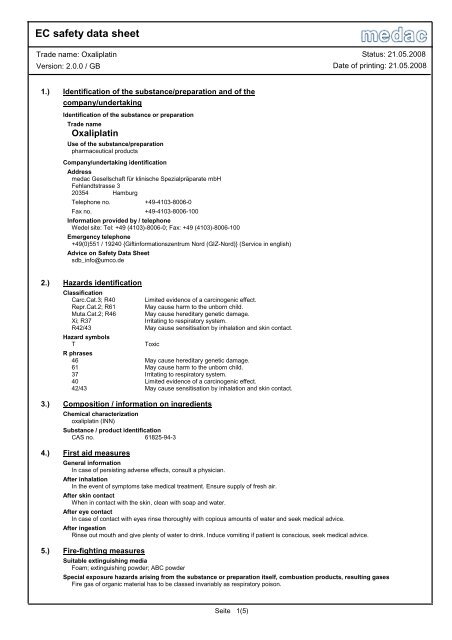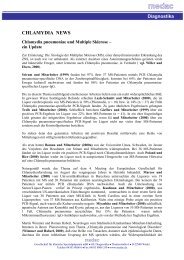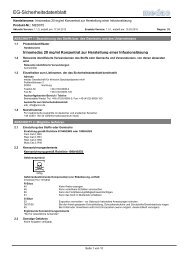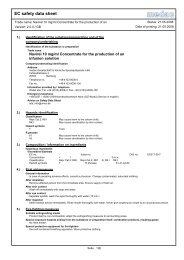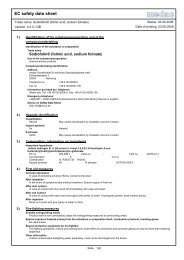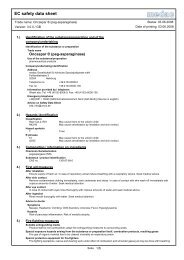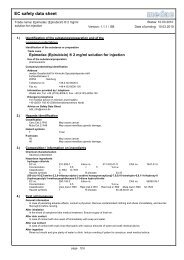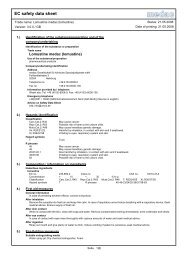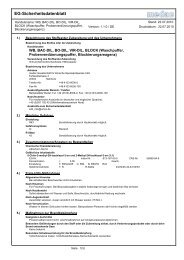oxaliplatin - medac GmbH
oxaliplatin - medac GmbH
oxaliplatin - medac GmbH
You also want an ePaper? Increase the reach of your titles
YUMPU automatically turns print PDFs into web optimized ePapers that Google loves.
EC safety data sheet<br />
Trade name: Oxaliplatin<br />
Version: 2.0.0 / GB<br />
1.) Identification of the substance/preparation and of the<br />
company/undertaking<br />
Identification of the substance or preparation<br />
Trade name<br />
Oxaliplatin<br />
Use of the substance/preparation<br />
pharmaceutical products<br />
Company/undertaking identification<br />
Address<br />
<strong>medac</strong> Gesellschaft für klinische Spezialpräparate mbH<br />
Fehlandtstrasse 3<br />
20354 Hamburg<br />
Telephone no. +49-4103-8006-0<br />
Fax no. +49-4103-8006-100<br />
Information provided by / telephone<br />
Wedel site: Tel: +49 (4103)-8006-0; Fax: +49 (4103)-8006-100<br />
Emergency telephone<br />
+49(0)551 / 19240 {Giftinformationszentrum Nord (GIZ-Nord)} (Service in english)<br />
Advice on Safety Data Sheet<br />
sdb_info@umco.de<br />
2.) Hazards identification<br />
Classification<br />
Carc.Cat.3; R40 Limited evidence of a carcinogenic effect.<br />
Repr.Cat.2; R61 May cause harm to the unborn child.<br />
Muta.Cat.2; R46 May cause hereditary genetic damage.<br />
Xi; R37 Irritating to respiratory system.<br />
R42/43 May cause sensitisation by inhalation and skin contact.<br />
Hazard symbols<br />
T Toxic<br />
R phrases<br />
46 May cause hereditary genetic damage.<br />
61 May cause harm to the unborn child.<br />
37 Irritating to respiratory system.<br />
40 Limited evidence of a carcinogenic effect.<br />
42/43 May cause sensitisation by inhalation and skin contact.<br />
3.) Composition / information on ingredients<br />
Chemical characterization<br />
<strong>oxaliplatin</strong> (INN)<br />
Substance / product identification<br />
CAS no. 61825-94-3<br />
4.) First aid measures<br />
General information<br />
In case of persisting adverse effects, consult a physician.<br />
After inhalation<br />
In the event of symptoms take medical treatment. Ensure supply of fresh air.<br />
After skin contact<br />
When in contact with the skin, clean with soap and water.<br />
After eye contact<br />
In case of contact with eyes rinse thoroughly with copious amounts of water and seek medical advice.<br />
After ingestion<br />
Rinse out mouth and give plenty of water to drink. Induce vomiting if patient is conscious, seek medical advice.<br />
5.) Fire-fighting measures<br />
Suitable extinguishing media<br />
Foam; extinguishing powder; ABC powder<br />
Seite 1(5)<br />
Status: 21.05.2008<br />
Date of printing: 21.05.2008<br />
Special exposure hazards arising from the substance or preparation itself, combustion products, resulting gases<br />
Fire gas of organic material has to be classed invariably as respiratory poison.
EC safety data sheet<br />
Trade name: Oxaliplatin<br />
Version: 2.0.0 / GB<br />
Special protective equipment for fire-fighters<br />
Use self-contained breathing apparatus.<br />
6.) Accidental release measures<br />
Personal precautions<br />
Use personal protective clothing. Cordon and mark contaminated area.<br />
Environmental precautions<br />
Do not allow to enter drains or waterways.<br />
Seite 2(5)<br />
Status: 21.05.2008<br />
Date of printing: 21.05.2008<br />
Methods for cleaning up/taking up<br />
Cover contaminated areas and collect spillage using spongy material (chemical pulp). After collection: clean possibly dried area<br />
using 70 % alcohol impregnated chemical pulp. Carry out final cleaning using soap solution impregnated pulp. Do not spray water<br />
or detergents directly onto the contaminated area and do not use a broom or vacuum cleaner; risk of aerosol or dust formation to<br />
which persons may be exposed.<br />
Additional informations (chapter 6)<br />
Information regarding Waste Disposal, see chapter 13.<br />
7.) Handling and storage<br />
Handling<br />
Advice on safe handling<br />
Avoid the formation and deposition of dust. Open and handle container with care. Only qualified and trained persons are<br />
authorised to handle<br />
Storage<br />
Further information on storage conditions<br />
Keep container tightly closed. Protect from heat and direct sunlight. Keep in a cool place. Store in a dry place.<br />
8.) Exposure controls / personal protection<br />
Exposure limit values<br />
N O N E<br />
Exposure controls<br />
Occupational exposure controls<br />
Handling of cytostatics / virusstatics calls always for separated, clearly marked working spaces in compliance with TRGS 525<br />
(technical provisions for hazardous substances).<br />
Personal protective equipment<br />
Respiratory protection<br />
If ventilation insufficient, use a respiratory protection apparatus.<br />
Respiratory filter (part): P3<br />
Hand protection<br />
When handling cytostatics / virostatics , always use protective gloves, tested according to EN 374. Take care that the gloves used<br />
cover the sleeves of the coat. Change gloves at least every 20 minutes; in case of visible contamination or damage, change gloves<br />
immediately.<br />
Appropriate Material nitrile (min. 0,3 mm)<br />
Appropriate Material butyl<br />
Appropriate Material rubber<br />
Eye protection<br />
Safety glasses (EN 166)<br />
Skin protection<br />
Impermeable protective clothing; apron<br />
General protective and hygiene measures<br />
It is essential for pregnant women to avoid inhaling the product and not to let it come in contact with the skin. Keep separated from<br />
food-stuffs and feed-stocks. Wash hands before breaks and after work. An antechamber equipped with separated storage facilities<br />
must exist for changing (protective clothes and normal clothes) before the working space (lock). At work do not eat, drink, smoke or<br />
take drugs.<br />
9.) Physical and chemical properties<br />
General information<br />
Form powder<br />
Colour whitish<br />
10.) Stability and reactivity<br />
Hazardous decomposition products<br />
No hazardous decomposition products known.
EC safety data sheet<br />
Trade name: Oxaliplatin<br />
Version: 2.0.0 / GB<br />
Thermal decomposition<br />
Remarks No decomposition if used as prescribed.<br />
11.) Toxicological information<br />
Effects after repeated or prolonged exposition (subacute, subchronic, chronic)<br />
Mutagenicity<br />
Value Can cause malformations.<br />
Remarks Information on genotoxicity in vivo available.<br />
Seite 3(5)<br />
Status: 21.05.2008<br />
Date of printing: 21.05.2008<br />
Reproduction toxicity<br />
Remarks Indications of toxic effects are available from reproduction studies in animals.<br />
Carcinogenicity<br />
Value probable carcinogen<br />
Experience in practice<br />
Irritates respiratory tract.<br />
Possible sensitisation potential with human beings.<br />
12.) Ecological information<br />
Other adverse effects<br />
Do not discharge product unmonitored into the environment.<br />
Ecological data are not available.<br />
13.) Disposal considerations<br />
Product<br />
Cytostatic remainders as well as with cytostatics contaminated materials can form both with preparation and with application.<br />
During formulation various quantities of following materials are produced:<br />
• residues of concentrated solutions of cytostatic agent (injections)<br />
• residues of diluted solutions (infusions, instillations)<br />
• empty material (original receptacles, syringes)<br />
• auxiliary means for formulation/preparation (cannula, swabs, pads, gloves etc.)<br />
Following waste materials are produced when used:<br />
• empty material (syringes, infusion receptacles)<br />
• cytostatic residues from injections, that have not been completely consumed<br />
• injection residues in hoses, infusion sets, unemptied bags/bottles of infusion<br />
Note:<br />
Collect waste material separately in suitable waste containers where produced (on cytostatic workbench in pharmacy, during<br />
preparation of administration, in the treatment room) and prepare for in-house transport.<br />
The legal provisions relating to waste of the respective state must be adhered to.<br />
German Federal States follow the so-called “Guidelines ruling the correct disposal of waste from health service facilities” issued by<br />
the Working Group of the Federal States on Waste (LAGA).<br />
Following cytostatic waste materials must be disposed of as hazardous waste (“special waste”):<br />
• original receptacles that are not completely emptied such as cytostatics resulting from discontinued therapy or unintended use<br />
• decayed CMR drugs in original packing<br />
• residues of dry substances and broken tablets<br />
• syringe barrel and infusion bottles / bags with visible filling level/residual contents (> 20 ml)<br />
• Infusions systems and other cytostatics contaminated material (> 20 ml)<br />
• material that has been evidently contaminated through spillage of large quantities of liquids or solids during preparation or use of<br />
the aforementioned drugs (i.e. pads, strongly contaminated individual protective equipment).<br />
Such waste needs to be collected in pedal bins or waste containers with an opening mechanism in order to avoid any direct contact<br />
of hands/gloves with the waste.<br />
According to the legal provisions relating to hazardous goods and waste, such waste needs to be placed in appropriate, airtight<br />
and sound containers for disposal at a special facility displaying the following information: “AS 18 0108* – Cytotoxic and cytostatic<br />
waste” and the proper UN No. (pls. see below) according to the Transport of Dangerous Goods Regulations.<br />
The ADR label No 6.1 (Symbol „skull and crossbones“) shall be always affixed to the disposal containers. According to the<br />
regulation on hazardous substances Gefahrstoffverordnung (GefStoffV) disposal containers containing cytostatics labelled with<br />
the ADR label No 6.1 need no additional labelling (hazard symbol T, skull and crossbones on an orange background).<br />
Cytostatic waste disposed of under the waste name “AS 18 0108* – Cytotoxic and cytostatic waste” shall be provided with one of<br />
the following UN No.:<br />
• UN 2810 “TOXIC LIQUID, ORGANIC, N.O.S.“: Suitable for liquid cytostatics residues. In case of low liquid quantities, the<br />
packaging must only comply with the requirements of the Packaging group III.<br />
• UN 2811 „TOXIC SOLID ORGANIC, N.O.S.“: Suitable for sold cytostatic residues (i.e. broken tablets) and strongly contaminated
EC safety data sheet<br />
Trade name: Oxaliplatin<br />
Version: 2.0.0 / GB<br />
Seite 4(5)<br />
Status: 21.05.2008<br />
Date of printing: 21.05.2008<br />
materials.<br />
• UN 3243 „SOLIDS CONTAINING TOXIC LIQUID, N.O.S.“: Can be used as an alternative to UN 2810 and UN 2811.<br />
Usually following low-contaminated waste does not fall under the scope of the aforementioned group of hazardous waste:<br />
• gauntlets<br />
• gloves<br />
• face masks<br />
• single-use lab coats<br />
• swabs<br />
• wipes<br />
• empty cytostatics containers after intended use (ampoules, syringes, infusion accessories, infusion receptacles)<br />
• air filters from safety workbenches<br />
Low contaminated cytostatic waste shall be collected in airtight, plastic bags before final disposal immediately at the point of origin.<br />
They are disposed of using the official code and name “AS 18 01 04 – Wastes whose collection and disposal is not subject to<br />
special requirements in order to prevent infection (for example dressings, plaster casts, linen, disposable clothing, diapers)”. They<br />
may be disposed of together with hospital waste (former B waste). Sharp or pointed objects such as cannula, transfer cannula,<br />
spikes and cullets shall be collected at the point of waste origin, in puncture resistant and safely closed containers (i.e. sharps bin).<br />
When disposing of waste that is containing cytostatics, the provisions of the respective local waste regulation must be adhered to<br />
(i.e. does exist a duty to offer to an official buyer).<br />
14.) Transport information<br />
Other information (chapter 14.)<br />
The product is not defined under national/international road, rail, sea and air transport regulations as a hazardous material.<br />
15.) Regulatory information<br />
Labelling in accordance with EC directives<br />
The product is classified and labelled in accordance with EC Directive 67/548/EC.<br />
<strong>oxaliplatin</strong> (INN)<br />
Hazard symbols<br />
T Toxic<br />
R phrases<br />
46 May cause hereditary genetic damage.<br />
61 May cause harm to the unborn child.<br />
37 Irritating to respiratory system.<br />
40 Limited evidence of a carcinogenic effect.<br />
42/43 May cause sensitisation by inhalation and skin contact.<br />
S phrases<br />
53 Avoid exposure --- obtain special instructions before use.<br />
22 Do not breathe dust.<br />
24 Avoid contact with skin.<br />
36/37 Wear suitable protective clothing and gloves.<br />
45 In case of accident or if you feel unwell, seek medical advice immediately (show the label where<br />
possible).<br />
Special labelling for certain preparations<br />
"Restricted to professional users"<br />
Restriction of occupation<br />
Observe employment restrictions for child bearing mothers and nursing mothers.<br />
Observe employment restrictions for young people.<br />
Council Directive 96/82/EC on the control of major-accident hazards involving dangerous substances<br />
Remarks Annex I no. 2<br />
16.) Other information<br />
Further information<br />
Processing notes Please read packing specification of the drug for additional drug related information.<br />
The data of this safety data sheet reflect the actual state of knowledge. The safety data sheet describes the product in view of its<br />
handling and safety relevant requirements of the pharmaceutical ingredient as bulk ware (chemical).<br />
Sources of key data used to compile the data sheet:<br />
EC Directive 67/548/EC resp. 99/45/EC as amended in each case.<br />
Regulation (EC) No 1907/2006 (REACH) as amended in each case.<br />
EC Directives 2000/39/EC, 2006/15/EC as amended in each case.<br />
National Threshold Limit Values of the corresponding countries as amended in each case.<br />
Transport regulations according to ADR, RID, IMDG, IATA as amended in each case.<br />
The data sources used to determine physical, toxic and ecotoxic data, are indicated directly in the corresponding chapter.<br />
Department issuing safety data sheet<br />
UMCO Umwelt Consult <strong>GmbH</strong><br />
Georg-Wilhelm-Str. 183 b, D-21107 Hamburg<br />
Tel.: +49 40 / 41 92 13 00 Fax: +49 40 / 41 92 13 57 e-mail: umco@umco.de
EC safety data sheet<br />
Trade name: Oxaliplatin<br />
Version: 2.0.0 / GB<br />
Seite 5(5)<br />
Status: 21.05.2008<br />
Date of printing: 21.05.2008


